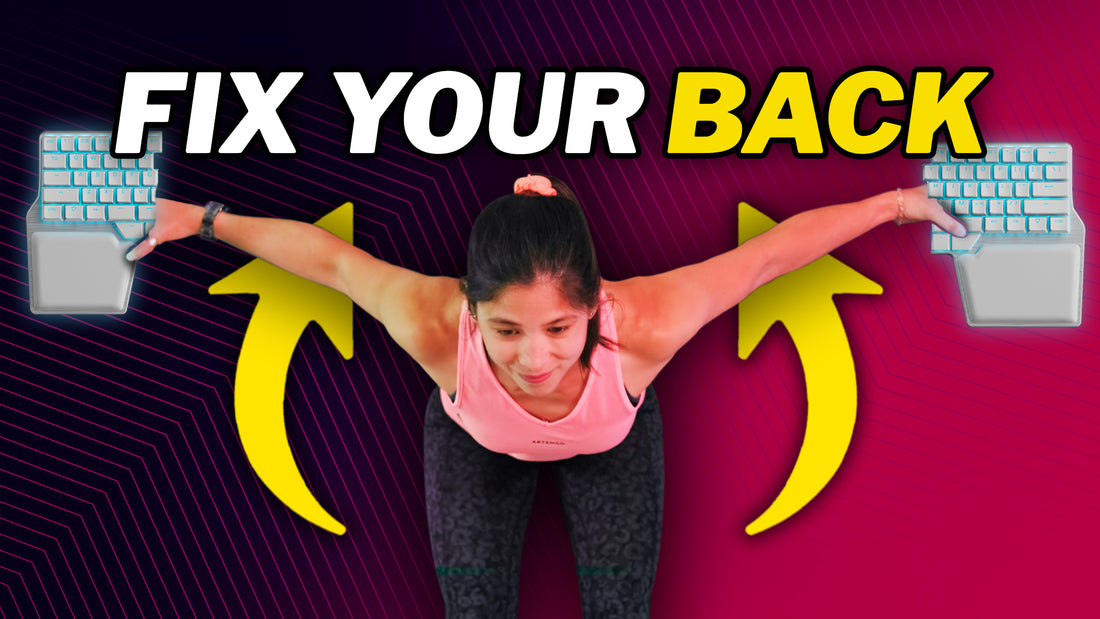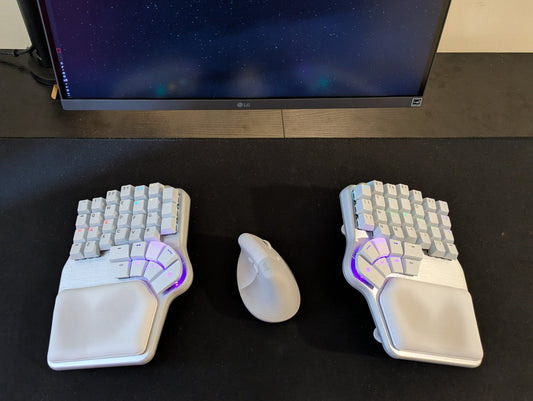If you bought an ergonomic keyboard and you're still experiencing discomfort or pain, don't be too quick to blame the keyboard.
It is just one piece of the puzzle for achieving an ideal ergonomic setup. This article will provide another part of the riddle: proper seating. It will also offer solutions to the most common postural problems. Let's dive in!
Attaining better posture:
Let's start with the basics, what is proper seating?
Ensure your feet are flat on the floor, knees at the level of your hips, and back upright. Your shoulders should be relaxed, with forearms parallel to the floor. Your desk height should match the level of your elbows, and your wrists should be in a neutral position while resting on your keyboard.
 But what if that does not straighten all out? What if the pain is diminished but persists?
But what if that does not straighten all out? What if the pain is diminished but persists?
The first recommendation is to always check with a doctor or a physical therapist: but if you want to try something first or prevent some future issues, here are some easy exercises you can perform even at your workplace.
Lumbago:
Commonly known as lower back pain, it can be worsened by poor seated posture and slouching.
Strengthening your core will help to maintain an upright posture while using your computer. That can be easily achieved with these exercises:

The Plank:
Start in a face-down position with elbows under your shoulders and forearms extended. Lift your body into a plank position with only your toes, elbows, forearms, and hands touching the floor. Keep a straight back; your head should look down on the floor.

Slow squats:
Stand with feet shoulder-width apart and toes slightly out. Bend the knees and keep your chest upright while inhaling. Pause when knees reach 90 degrees, then exhale and rise at a controlled speed.

Glute bridges:
Lie on your back with your feet on the floor, knees up, and hands at your sides. Drive through your heels and raise your glutes off the floor, bringing your hips upwards. Inhale and slowly lower your body back down to the starting position.

Bird dogs:
Extend one leg and the opposite arm straight out on all fours. Keep your back flat and create a straight line across your body. Repeat on the other side.

You don't have to do this every time you take a break, doing three sets of thirty seconds of each exercise twice weekly.
Rounded shoulders:
A.k.a Postural Kyphosis. Often caused by slouching and finally forcing the shoulders forward. Also known as "mom posture," this condition is commonly associated with keyboard users, mainly because keyboards push the hands together.
To avoid it, we have to strengthen the muscles in the upper back with the following exercises:
Standing chest opener:
Interlock your fingers behind your head and extend your elbows outwards while standing comfortably. Gently push your chest forwards while drawing your elbows back slightly to feel the stretch across your chest.

Bent over rows:
You will need some small weights; you can work with a couple of water bottles, so you can't duck out. Place your feet slightly narrower than shoulder-width apart with a slight bend at the knee. Pivot forward at the hips, bringing your torso down almost parallel to the floor. Extend the water bottles straight down toward the floor. Then bring the bottles up towards your chest, allowing your elbows to run closely past your body. Aim to bring your elbows slightly past the level of your ribcage and return to the initial position.

Shrugs:
Hold water bottles firmly by your thighs, with palms facing in. Stand with feet shoulder-width apart and a slight knee bend. Lift shoulders towards ears, pause, then lower back down.

Wall chest stretches:
Stand with your right shoulder next to a wall. Place your right hand above your head and rest it on the wall. Lower your arm behind you while keeping in contact with the wall. Turn away from your right arm for a stretch.

As with the previous exercises, three thirty seconds sets for each exercise twice a week will help to improve your shoulder position. Of course, you can do some more if you feel like it!
These exercises also help against the Upper-Crossed Syndrome, but if you're suffering from it or you spend lots of hours working on a laptop, try our bonus track:
Chin tucking:
Face straight ahead and draw your chin down towards your upper chest. Hold this stretch for between twenty to thirty seconds before slowly releasing.

Conclusion:
While ergonomic keyboards are vital in maintaining a healthy posture, they are just one aspect of the equation. Pay attention to your setup, incorporate stretching exercises, and take regular breaks to take walks or hydrate. Adopting a holistic approach to posture can create an environment that promotes long-term comfort and reduces the risk of injury.
Besides, doing these exercises should not take longer than an hour each week; you have no reasons to slack off.
Besides, if you still have problems with these exercises, Coach Dom will solve any doubt you might have in this video:









